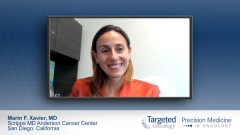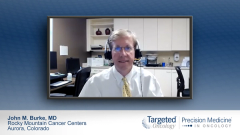
Individualized Therapy for Unfit Patients With R/R DLBCL
Implications for treating unfit patients with relapsed/refractory diffuse large B-cell lymphoma with chemotherapy or the combination of tafasitamab and lenalidomide based on patient characteristics and the L-MIND trial.
Episodes in this series

Marin F. Xavier, MD: For unfit patients, what are your thoughts?
John M. Burke, MD: Unfit patients have a lot of options. Those include some of the ones we’ve mentioned: the tafasitamab and lenalidomide, and loncastuximab just got approved. We’ve had POLA-BR [polatuzumab, bendamustine, rituximab] for a few years and selinexor as well. There are a number of options. The question is how do you sequence these? Is there a best sequence? What’s the best option? We don’t have all the answers from the data. A lot of it is trying to individualize the best fit for that patient. That’s my thinking. What about yours?
Marin F. Xavier, MD: Using polatuzumab has been 1 of the few advances in this field until the last, I’d say, year. We started using polatuzumab with rituximab-bendamustine. Just 1 comment on that. Bendamustine is T-cell depleting, so I always get nervous if I know somebody is going to go to get CAR [chimeric antigen receptor] T cells. I do what you do, an R-ICE [rituximab, ifosfamide, carboplatin, etoposide] or R-GDP [rituximab, gemcitabine, dexamethasone, cisplatin] regimen. If somebody is truly unfit, they’re not going to get CAR T. I’m a big user of tafasitamab-lenalidomide just based on the L-MIND trial. The long-term follow-up is fairly impressive. The 3-year follow-up data had over 30 months; it was a [correlation] basically. If the patients responded, they responded for 3 to 4 years, which was extremely meaningful because that’s a long time for a disease that was previously binary—either you were cured or you died. That was my past practice, but now we have this new area of living with your disease. So that’s been my go-to.
I’m very excited to start using loncastuximab, but so far my responders for tafasitamab haven’t progressed, so I haven’t used it. I don’t know if it would work after tafasitamab. We don’t know that for CD19. Some people we test, we biopsy, to make sure the CD19 is still positive. That’s been used in a lot of these data about sequencing with CAR T and stuff like that. Tafasitamab-lenalidomide is the 1 I always forget. What was the L-MIND trial? I think the 3-year follow-up showed us it was 40-something months. That’s the 1 I always forget. It’s between 3 and 5 years, which is a long time.
John M. Burke, MD: The median duration of response was 44 months.
Marin F. Xavier, MD: Yes, 44 months. That’s a really important number in clinical practice. It’s a long time for a disease that refractory/relapsed patients never lived beyond 6 months with. That’s been my go-to for the unfit. If they do respond, I have a big happy dance with my patients. I tell them they’re likely to respond for a significant period of time. I just had a lady in the clinic with her first—after 3 months of therapy, she had mainly hepatosplenic disease, and her organomegaly resolved after the third month. For me, I’ve had a very positive experience so far. In the beginning I thought the lenalidomide was better tolerated, but now that I’m treating more people who are less fit and older, most of the toxicities relate to the lenalidomide, and I’ve been dose reducing. But it’s another area of question. Is indefinite every-2-week monoclonal antibody even necessary? If you’re having that long of a response, are we potentially curing? Do we need to have an indefinite tafasitamab infusion? Lenalidomide is just for the first year.
John M. Burke, MD: What’s your strategy for the lenalidomide? Are you starting everyone at full dose, or are you dose reducing early on?
Marin F. Xavier, MD: Yeah, I am.
John M. Burke, MD: Do you use the eyeball test?
Marin F. Xavier, MD: The first group of patients I treated werereally sick because they were very refractory. A lot of them I could barely even get the lenalidomide in because of marrow reserve in those heavily pretreated patients. In those patients I dose reduced for baseline cytopenias, organ dysfunction, and renal insufficiency. I talked to a lot of my colleagues about this, and many say that in the second-line setting, patients are robust and tolerate the dose—was it 20 or 25 mg in the trial? They claimed that this is well tolerated, and I was very excited it’s well tolerated. Better than in patients with myeloma. The more clinical experience I get, I’m not so convinced. Most of the toxicity lies in that.
The other thing is that this is combination therapy, and you need the immunomodulator. My patients who are unfit and don’t want to do a cellular therapy or transplant evaluation, they don’t want to tolerate a lot of toxicity in general. I’m finding that they’re always trying to get away with doing just the antibody. I don’t blame my 86-year-old lady for wanting to be minimalistic because she just wants to live well. As she progressed, just in 1 area, we [INAUDIBLE] her. When she comes back I threatened her with adding lenalidomide or doing the loncastuximab. It’s a palliative therapy, so the tolerability for toxic effects is a little lower in terms of goals of care. We’re seeing very old people who, for the first time, can be treated with relapsed disease without intensive treatment. This is a new world for large cell.
John M. Burke, MD: I agree. As you said, the median duration of response is long and their progression-free survival curves are really impressive. A significant percentage of people is still alive and in remission 3 to 4 years from starting their treatment. Who knows? It’s too early to say they’re cured.
Marin F. Xavier, MD: That 44 months always confuses me because it’s a 3-year follow-up.
John M. Burke, MD: It’s too early to say they’re cured, but when you get to 3 and 4 years of not having a relapse in large cell lymphoma, you wonder.
Marin F. Xavier, MD: I misspoke. It’s not monotherapy for large cell. I’ve been using it off-label in other B-cell lymphomas that are indolent, and it’s been effective in certain scenarios.
Transcript edited for clarity.







































